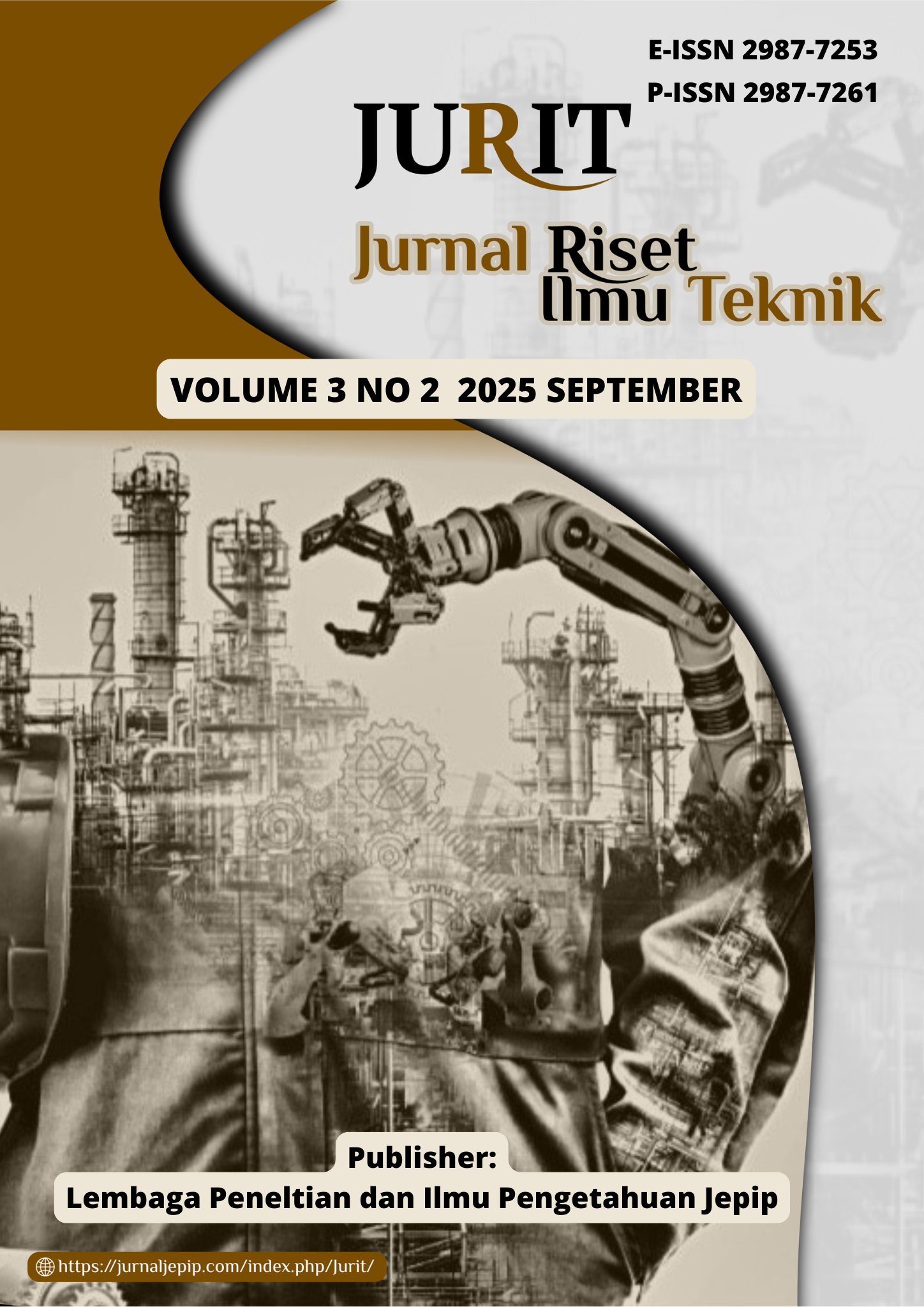Sustainable Quality Transformation In Agro-Industrial Manufacturing: A Six Sigma–Kaizen Model For Thailand’s Crude Palm Oil Sector
DOI:
https://doi.org/10.59976/jurit.v3i2.195Abstract
This study enhances the process capability and sustainability of Thailand’s crude palm oil (CPO) production through the integration of Six Sigma DMAIC and Kaizen frameworks. Although Thailand ranks as the world’s third-largest palm oil producer, its CPO frequently fails to meet international standards due to excessive Free Fatty Acid (FFA) and moisture content. To address these persistent inefficiencies, a quantitative–descriptive approach was applied to a Krabi Province mill using 30 days of operational data. The DMAIC methodology systematically identified root causes—unstable sterilization temperature, pressing delays, and inadequate vacuum maintenance—while Kaizen interventions reinforced operator discipline and preventive control. Post-intervention analysis revealed a 19% reduction in FFA, a 36% decrease in moisture, and a 53% reduction in defect rate, accompanied by a rise in process capability index (Cp) from 0.78 to 1.24 and an improvement in sigma level from 4.09 to 4.5. Benchmarking confirmed that Thailand’s performance now closely approaches Malaysia’s automation-led systems while surpassing Indonesia in consistency and energy efficiency. The findings demonstrate that sustainable process improvement can be achieved through data-driven analysis and human-centered Kaizen culture, even in semi-automated contexts. This hybrid model supports compliance with RSPO, ISO 22000, and Bio-Circular-Green (BCG) frameworks while reducing operational waste and cost. The originality of this research lies in establishing an empirically validated Six Sigma–Kaizen hybrid applicable to ASEAN agro-industries, bridging the gap between technological advancement and behavioral quality systems toward globally competitive CPO production.
Downloads
References
S. Ahmed, “Optimizing Small Cell Performance: A New MIMO Paradigm With Distributed ASTAR-RISs,” IEEE Open J. Veh. Technol., vol. 6, pp. 128–144, 2025, doi: 10.1109/OJVT.2024.3509736.
I. T. B. Widiwati, “The implementation of Lean Six Sigma approach to minimize waste at a food manufacturing industry,” J. Eng. Res. Kuwait, vol. 13, no. 2, pp. 611–626, 2025, doi: 10.1016/j.jer.2024.01.022.
Y. Trakulsunti, “Reducing medication errors using lean six sigma methodology in a Thai hospital: an action research study,” Int. J. Qual. Reliab. Manag., vol. 38, no. 1, pp. 339–362, 2021, doi: 10.1108/IJQRM-10-2019-0334.
W. Phumanee, “Tiger density, movements, and immigration outside of a tiger source site in Thailand,” Conserv. Sci. Pract., vol. 3, no. 12, 2021, doi: 10.1111/csp2.560.
H. G. Harold, “How convergent are rice export prices in the international market?,” Agric. Econ. United Kingdom, vol. 54, no. 1, pp. 127–141, 2023, doi: 10.1111/agec.12758.
W. Mekhum, “Role of green supply chain management strategies in sustainability: Evidence form manufacturing industry of Thailand,” Int. J. Supply Chain Manag., vol. 9, no. 1, pp. 232–238, 2020, [Online]. Available: https://www.scopus.com/inward/record.uri?partnerID=HzOxMe3b&scp=85080885275&origin=inward
S. Lobo, “Integrating design for lean six sigma (DFLSS) with the stage gate phases of the innovation management assessment framework (IMAF),” Benchmarking, 2024, doi: 10.1108/BIJ-04-2023-0205.
V. Yurayart, “Signal-on aptamer-based lateral flow test strip for sensitive cadmium detection,” Talanta, vol. 295, 2025, doi: 10.1016/j.talanta.2025.128365.
S. R. Lobo, “Comparative analysis of innovation management between ANZ (Australia, New Zealand) and TMSV (Thailand, Malaysia, Sri Lanka and Vietnam) regions,” Int. J. Qual. Reliab. Manag., 2025, doi: 10.1108/IJQRM-09-2023-0283.
O. Buthphorm, “Quality Improvement through DMAIC: A Case Study of Wire Harness Tape Manufacturing,” J. Multidiscip. Soc. Sci., vol. 17, no. 2, pp. 40–47, 2021, [Online]. Available: https://www.scopus.com/inward/record.uri?partnerID=HzOxMe3b&scp=85170708565&origin=inward
K. H. Hsu, “Development and Validation of Radiometric Calibration Procedures for THEOS-1 Satellite,” 2024. doi: 10.1117/12.3041625.
A. Watthanamaitri, “Improving Hitting Effect Between Grip and Base of Assist Grip in Trucks by The Six Sigma Approach,” 2022. doi: 10.1145/3535782.3535826.
“MSIE 2023 - 2023 5th International Conference on Management Science and Industrial Engineering,” 2023. [Online]. Available: https://www.scopus.com/inward/record.uri?partnerID=HzOxMe3b&scp=85171165699&origin=inward
T. Piamsak, “Defective Reduction in Assembly Process of Sound Absorption Insulator Part Missing in Car Body Metal by Six Sigma Approach,” 2025. doi: 10.3233/ATDE250546.
Y. Luo, “An energy-based method for uniaxially compressed rocks and its implication,” J. Rock Mech. Geotech. Eng., vol. 17, no. 3, pp. 1429–1444, 2025, doi: 10.1016/j.jrmge.2024.07.002.
D. Skalli, “Integrating Lean Six Sigma and Industry 4.0: developing a design science research-based LSS4.0 framework for operational excellence,” Prod. Plan. Control, vol. 36, no. 8, pp. 1060–1086, 2025, doi: 10.1080/09537287.2024.2341698.
S. H. De Silva, “Barriers and strategies for implementing lean six sigma in small- and medium sized enterprises (SMEs) in construction industry: a fuzzy TOPSIS analysis,” Constr. Innov., vol. 25, no. 2, pp. 510–551, 2025, doi: 10.1108/CI-09-2022-0225.
J. Mohan, “An analysis of green lean six sigma deployment in MSMEs: a systematic literature review and conceptual implementation framework,” TQM J., vol. 37, no. 3, pp. 747–777, 2025, doi: 10.1108/TQM-06-2023-0197.
A. Fayyaz, “Untangling the cumulative impact of big data analytics, green lean six sigma and sustainable supply chain management on the economic performance of manufacturing organisations,” Prod. Plan. Control, vol. 36, no. 8, pp. 1137–1154, 2025, doi: 10.1080/09537287.2024.2348517.
E. G. Santacruz, “Integrated quality 4.0 framework for quality improvement based on Six Sigma and machine learning techniques towards zero-defect manufacturing,” TQM J., vol. 37, no. 4, pp. 1115–1155, 2025, doi: 10.1108/TQM-11-2023-0361.
Y. Gong, “Reconfigurable and nonvolatile ferroelectric bulk photovoltaics based on 3R-WS2 for machine vision,” Nat. Commun., vol. 16, no. 1, 2025, doi: 10.1038/s41467-024-55562-7.
M. Arora, “The Impact of Industry 4.0 Technologies on Operational Excellence Methods: Application of Fuzzy Topsis,” EMJ Eng. Manag. J., vol. 37, no. 4, pp. 343–354, 2025, doi: 10.1080/10429247.2024.2443703.
D. Çelik, “A review of energy storage systems for facilitating large-scale EV charger integration in electric power grid,” 2025. doi: 10.1016/j.est.2025.115496.
Q. Sun, “Visible-Light-Induced Energy-Transfer-Mediated Hydrofunctionalization and Difunctionalization of Unsaturated Compounds via Sigma-Bond Homolysis of Energy-Transfer Acceptors,” 2025. doi: 10.1021/acscatal.4c07316.
A. Tusha, “Interference Burden in Wireless Communications: A Comprehensive Survey From PHY Layer Perspective,” IEEE Commun. Surv. Tutorials, vol. 27, no. 4, pp. 2204–2246, 2025, doi: 10.1109/COMST.2024.3487068.
P. Bhide, “Review on 6G communication and its architecture, technologies included, challenges, security challenges and requirements, applications, with respect to AI domain,” 2025. doi: 10.1049/qtc2.12114.
J. Wang, “Energy Management of a Plug-In Hybrid Electric Vehicle Using Bayesian Optimization and Soft Actor-Critic Algorithm,” IEEE Trans. Transp. Electrif., vol. 11, no. 1, pp. 912–921, 2025, doi: 10.1109/TTE.2024.3398046.
Downloads
Published
How to Cite
Issue
Section
License
Copyright (c) 2025 Saswattecha Nantakrit Yodpijit, Somjai Wangrakdiskul, Nattaya Charoensuk, Kanyarat Phromphat, Chalita Boonmee

This work is licensed under a Creative Commons Attribution 4.0 International License.

















